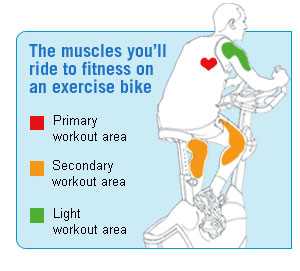 How to choose the best exercise bike
How to choose the best exercise bike
Great for building endurance and cardiovascular fitness, cycling with an exercise bike or spin bike is a low impact workout that can be performed just as easily from the comfort of your own home. Finding the right exercise bike though can be difficult. From the type of bike, to the resistance options, level of comfort and price, specifications and other features, deciding can prove difficult. Here we present an explanation on exercise bikes – everything you need to know to help you choose the right one.
What is the difference between an upright and recumbent exercise bike?
You need to decide whether you want an upright, spin or recumbent exercise bike. Each type has its own benefits:
- An upright exercise bike is similar to a regular bike you would pedal on the road, but with a larger comfortable seat. They take up less room than recumbent exercise bikes, so if space is an issue then the upright bike might be the more suitable option. In general, upright bikes require that you to step over the frame of the bike before sitting. The seating position is comfortable, with a gentle leaning forward position.
- Recumbent exercise bikes are better suited to people who require a larger seat and/or back support. Recumbent bikes also enage more of the glute muscles (bum) than upright bikes. They have a more comfortable seating position (leaning back) and generally provide better support for the back and the glutes. Recumbent bikes often have a "step-through" design, which makes it easier to get onto the bike and are ideal for the elderly or physicaly disabled.
- Spin Bikes are generally much heavier, with heavy fly-wheels and smaller uncomfortable seats. Suitable for professionals and those seeking a true alternative to road cycling.
Do you choose on Quality or Price?
The quality of an exercise bike is proportional to the price. A cheaper priced exercise bike may mean more cash saved, but also means you’re compromising comfort and features that allow for a smoother ride. As you spend more on an exercise bike, the features, specifications and quality do improve.
Generally, the price of exercise bikes are as follows:
- Under $300 - lightweight bike with small basic console and light flywheel (approx 4kg).
- $300 to $500 - good home use bike with strong frame and large LCD console, medium flywheel (approx 5kg - 6kg)
- $500 to $1000 - premium home use exercise bike, solid frame, large, clear LCD console, heavy flywheel (approx 7kg - 9kg)
- Over $1000 - commercial-grade exercise bike, heavy-duty frame, self-generating power supply, high-level resistance flywheel (10kg+)
What does the flywheel do?
As you pedal an exercise bike, a flywheel provides a level of resistance and motion to your pedaling action. The size and weight of the flywheel varies between the models, with spin bikes having the heaviest flywheels (up to 25kg). The heavier the flywheel, the more inertia is required to crank the flywheel (make it spin). Also, the heavier the flywheel, the smoother the bikes feels (a feeling of quality is conveyed from bikes with heavier flywheels).
The resistance is also provided between the braking mechanism (magnetics or friction pad) and the flywheel.
What kind of resistance is best?
There are three types of resistance on exercise bikes.
- Friction Resistance (Fabric Belt or Felt Pad) - Friction Resistance is the cheapest type of resistance available. It uses a felt pad or fabric belt against the flywheel that can be manually tensioned to increase the level of resistance. It is the least reliable as pads often wear-out with use. Needs regular maintenance.
- Magnetic Resistance - Magnetic Resistance is the most common type of resistance used in exercise bikes. It works by using an adjustable series of ferrous magnets that surround the flywheel, and is controlled either a manual dial or by a programmable computer console. It is the most reliable of the three types.
- Electro-Magnetic Resistance - a powerful type of magnetic resistance found in high-grade and commercial-grade exercise bikes. A copper coil wire surrounds the flywheel and an electrical current is put through the coil. It can provide an adjustable, strong electro-magnetic resistance for seriously hard training. Controlled by a programmable computer console.
What features should I look for in the computer console?
The computer console displays your pedaling information and is your interface to your bike. Features that are essential are accurate feedback including exercise time, distance, speed, RPM (Revolutions Per Minute) and heart rate. The more advanced consoles will also include calories used, energy resistance (Watts) and cadence. The computer console should also include a variety of in-built training programs to keep your workouts interesting. The more programs, the better. The exercise bike should include Heart Rate Training programs.
What else should I look for when buying an exercise?
When choosing a bike, you need to determine the criteria that suits. Some are unnecessarily complex. We have attempted to list the most important criteria when buying an exercise bike. To summarise, the main criteria are:
- price and build quality,
- warranty,
- frame type (upright, recumbent or spinning bike),
- flywheel weight and size,
- resistance type,
- computer console features.
We hope this information assists you in making the right choice for your exercise bike.
What is the best exercise bike?
The best exercise bike is one that meets all your criteria for a good bike. The Fitness Market choice for best exercise bikes are: 
Upright Exercise Bikes
- Under $300 - Falcon Manual Exercise Bike
- Under $550 - Aquila Silverline Exercise Bike
- Over $550 - Aero Exercise Bike
Recumbent Bike
- Under $1000 - Infiniti PG800R Recumbent Exercise Bike
- Over $1000 - Sportop RB300 Recumbent Exercise Bike
Spin Bike
- Under $1000 - Ablaze STD-68 Pro Spin Bike
- Over $1000 - Ablaze OB-12 Commercial-Grade Spin Bike
Should you have further questions, the friendly, expert Fitness Market staff are willing to help you. Call us on 1300 557 773













